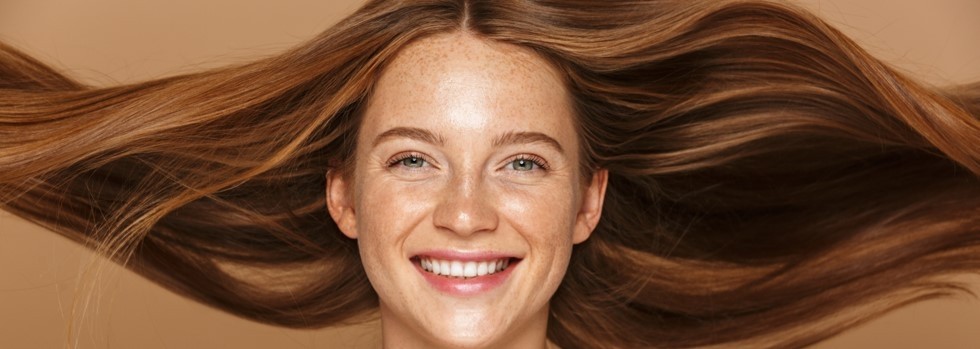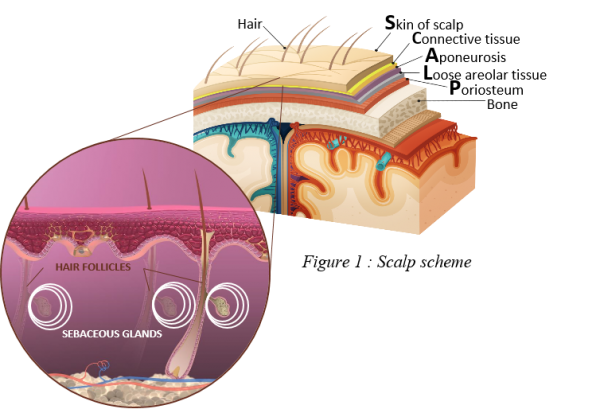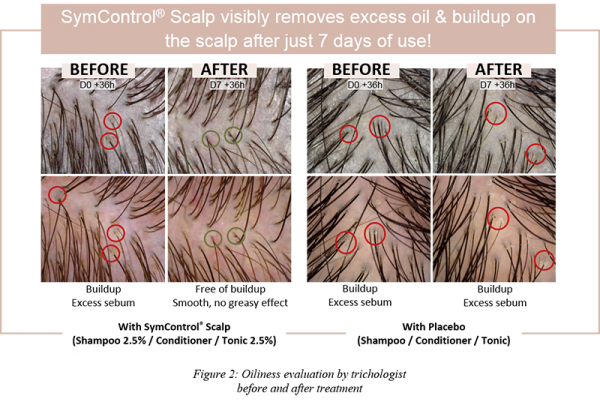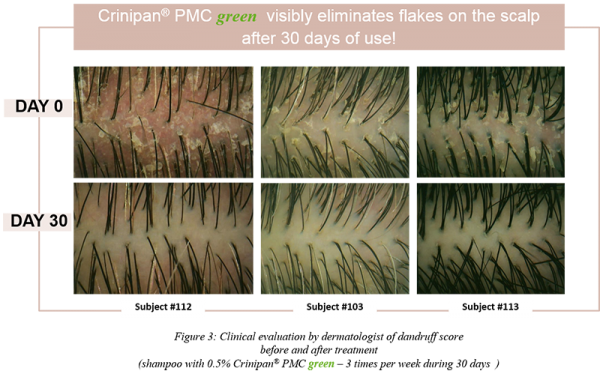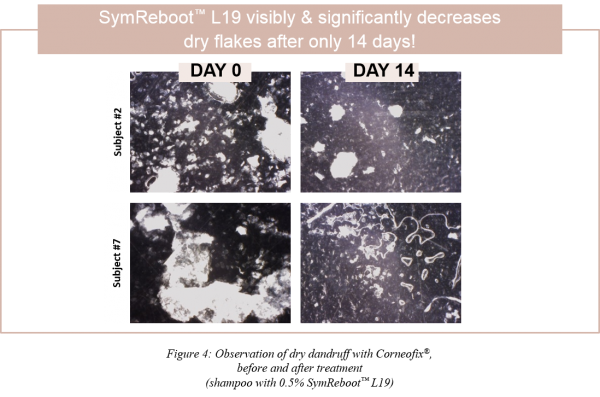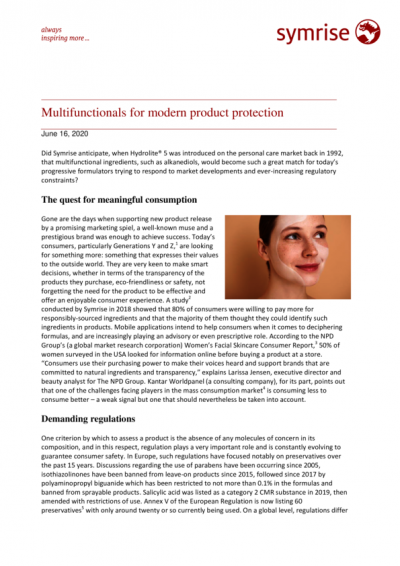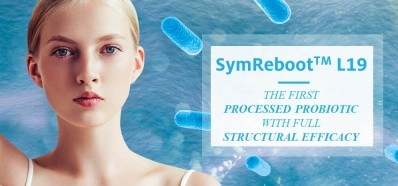Promotional Features
Hot topic: Skinification of the scalp
Today, skin care is more than ever influencing other beauty categories like hair care and more particularly scalp care. Skincare’s ingredients and formats (serums, scrubs, overnight masks, etc.) are already reaching the scalp care market that both brands and suppliers are investing in.
To explore this new focus, it’s necessary to understand consumers’ attitudes and expectations in this area. Thus, we discovered that scalp care is becoming a wellness focus, with 93% of consumers already taking care of their scalp as an essential part of their beauty routine. The reason why? Scalp health is above all a question of comfort, well-being and self-confidence. These insights* highlight a new key beauty priority for consumers and how important it is to treat your scalp with as much care as you do for your skin.
Invested to continuously fulfill consumers’ needs, and based on its long-term expertise in both hair and skin care, Symrise has transferred its knowledge to scalp care. As such, we went deeper in the understanding of scalp specificities and the imbalance at the origin of scalp disorders in order to develop dedicated solutions to get a healthy scalp.
What you need to know about your scalp
The scalp is the bridge between skin and hair, but also nothing else than an extension of the skin. The origin of the scalp’s name comes from the five layers that it is composed of (see figure 1) where the outer one is the skin.
Scalp skin is similar to other skin areas of the body but has some specificities. Indeed, it is the thickest skin of the body which is richly irrigated with more blood vessels. It also has an abundance of hair follicles which are attached to numerous and larger sebaceous glands. Thus, it can become more easily dirty from sweat and sebum.
Like any other part of the body, the scalp has its specific microenvironment mainly dominated by Malassezia species and C. acnes bacteria. This specific microbiota plays a microbiome function that together with the scalp’s skin acts as the first defense line against exogenous factors (barrier function). Also, the scalp carries numerous sebaceous glands responsible for producing sebum. These lipids, also known as scalp lipidome, naturally protect the scalp from environmental aggressions, lubricate hair fibers and help prevent water loss.
The scalp appears to be a reactive ecosystem that needs special attention. Indeed, skin issues are more likely to happen in it and if the scalp is unbalanced, the whole ecosystem is affected.
Healthy scalp is the root for beautiful hair!
The scalp is the location of hair follicles and hair health starts at its roots. In good health, the hair follicles have a proper environment to produce the keratin that generates healthy and beautiful hair. The hair follicles could be impacted by scalp imbalance issues, like lower blood circulation, excess sebum or dandruff that have negative impact on the hair fiber.
But how to maintain the scalp in a healthy state? Multiple factors such as lifestyle, environment, genetics, daily grooming and chemical treatments have a direct impact on scalp balance. The scalp is a complex ecosystem where three key factors must be balanced: the lipidome (scalp sebum), the microbiome and the integrity of the barrier function.
Like skin, there are different types of scalp (oily, dry, sensitive, itchy, with dandruff...) but all of them produce sebum at a more or less regular level. Both quantity and quality of sebum are important for scalp health. Indeed, an unhealthy scalp can be caused by a lipidome imbalance, either sebum overproduction or under-production. Due to genetics, lifestyle but also over-washing of the hair, the scalp is affected and then produces too much sebum to protect itself, resulting in an oily scalp and dirty, greasy hair. Moreover, the overproduction of sebum is a trigger for over-proliferation of Malassezia species that leads to a microbiome dysbiosis meaning a change in microflora’s composition. This could be at the origin of dandruff (oily flakes), itching, redness or even malodor and discomfort.
The other way around, a lower production of sebum and lipids content can also happen and is often linked to a weakened barrier function. These are the reasons why your scalp and hair get dry causing dry dandruff (smaller flakes falling onto shoulders), itching, redness, atopic or xerotic eczema. Indeed, the barrier of a dry scalp is over-exposed and then more vulnerable to external aggressions increasing hypersensitivity, tightness and discomfort. These scalp issues are affecting the hair cycle balance and have visible and direct consequences on hair like hair loss, thinning hair, etc.
Finally, the challenge is to maintain a balance of the lipidome, microbiome and the barrier function for healthy scalp and hair.
Next generation of scalp care ingredients
Targeting lipidome balance
Did you know that more than one-quarter of global consumers* are concerned by oily scalp? But no need to strip your strands with excessive washing. There is another way to bring life back to your scalp and hair! At the cutting edge of technology, Symrise has developed a new solution for oily scalp and hair: SymControl Scalp.
SymControl Scalp is a COSMOS-approved natural ingredient based on renewable microalgae from the Mediterranean Sea called Tetraselmis suecica. This extract has been developed in a sustainable way through an eco-friendly blue biotech process with a low impact on the environment. It targets sebum overproduction at its source by balancing the expression of key mediator COX-2, involved in sebum secretion. In vivo studies prove that it visibly reduces the accumulation of sebum on scalp and minimizes the appearance of oily hair for 92% of volunteers after the first week of shampoo use.
As such, the scalp is left with a long-lasting clean sensation and consumers can space out hair washes. It also protects hair against damages caused by UV exposure and improves hair luster, which together with sebum reduction efficiency leads to healthy-looking hair.
Dealing with itching, a sign of an unhealthy scalp
Whatever the cause of an itchy scalp (stress, pollution, dandruff or just a tight ponytail), we have the solution: SymSoft Scalp delivers comfort and relief to itchy scalp while protecting the hair.
It is a smart complex of ingredients dedicated to reducing the sensation of scalp discomfort by a complementary mode of action on the regulation of itching mediators NK-1R and PAR-2. Its double action focuses on a neurosensory chain reaction which successfully fights the source of itchiness with an efficacy proven in vivo, at 1% in shampoo, showcasing a significant reduction of scalp itchiness (-35%) within 5 days of application. It has also positive results on hair: ex vivo tests on hair fibers have proven a visible improvement of hair elasticity and resistance to stress and breakage but also a protection of hair keratin from damages caused by chemical treatments like bleaching.
Consumers suffering from itchy scalp, greasy roots, oily hair or even hair loss are more likely to have dandruff, a top scalp care concern with more than one-third of consumers looking for a solution against dandruff*.
What if you could get a flake-free scalp with a green solution?
Crinipan PMC green is the first micro-activated naturally derived anti-dandruff active opening new opportunities for dandruff control strategies. With equivalent activity to the established benchmark climbazole, the new molecule combines effectiveness and a smart mode of action. Crinipan PMC green´s activity relies on Malassezia´s natural dependence on sebum lipids. It “tricks the yeast” thanks to its similar chemical structure: Malassezia’s lipases cleave the molecule to release the actual active that will in turn downregulate Malassezia activity. This leads to a reduction of dandruff, scalp redness and itching. Moreover, the green, sustainable and solvent-free production process, with optimal atom economy and using 100% plant-based raw material, leads to a Natural origin index of 1.
When used at 0.5% in shampoo, Crinipan PMC green reduces dandruff significantly:
Unlike dandruff caused by excess of sebum and Malassezia species, dry flakes are induced by a weakened scalp barrier. The lipid film of the dry scalp is damaged and induces a fragility of the barrier function that leads to increased water loss, impaired desquamation and higher susceptibility to external aggressors. Luckily, SymReboot L19 is the right solution!
Microbiotic solution for sensitive and dry scalp, SymReboot L19 is based on heat-treated probiotics behaving like probiotics – due to the nearly intact bacterial structure, although no longer viable, transporting and delivering the totum of the bacterium components. Restoring the scalp’s own natural defenses for a sustainably strengthened barrier, it visibly improves dry scalp condition by reducing dry flakes after only 2 weeks of treatment with shampoo and by soothing scalp discomfort (redness and itching).
* Source: Symrise Scalp Care Exploration Study 2020 - Global Report - Feb 2020
Disclaimer: The information provided herein is for informational purposes only. Symrise does not endorse and makes no representation that this cosmetic raw material is a drug active or biocidal ingredient. Companies should consult with legal counsel for any claims that they wish to make on their finished product, as it is their responsibility to ensure compliance with all applicable laws and regulations in the country the product is being marketed in.
